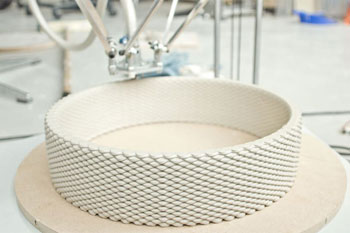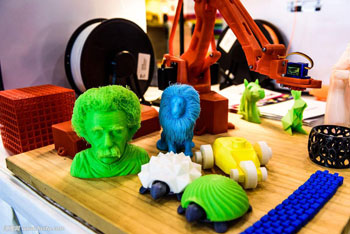3D printing is the abbreviation of three-dimensional print, and it’s also called additive manufacturing. It refers to the technology that can create a 3D solid object. The 3D printing process turns the virtual design into physical objects. In this process, The 3D model files of the needed products are hierarchically processed by a 3D printing device.
And then, by laser irradiation or other methods, certain specific materials are stacked layer by layer. Compared with traditional manufacturing methods, 3D printing technology has the advantages of short manufacture cycle, forming without limit of the complexity of parts, saving material and energy, etc. Therefore, whether at home or abroad, 3D printing technology is highly valued, some people even think that it will take the lead in the arrival of a new round of industrial revolution. At present, 3D printing has gradually played a significant role in the fields of industrial manufacture, biomedicine, construction, cultural art, etc.
1. What is 3D printing technology?
1.1 Introduction
What is 3D printing technology? Generally speaking, it refers to a process, including three steps. First, use the computer to establish a digital model; second, search for suitable materials (for example, metal, plastic, nylon, etc.); third, use digital models to print layer by layer according to the computer and finally create a physical object.
There are many manufacturing technologies for 3D printing. At present, they are mainly composed of fused deposition modeling, stereolithography apparatus, selecting laser sintering, laminated object manufacturing, and three-dimensional printing and gluing.
1.2 The advantages of 3D printing technology
An extensive range of application
Theoretically, as long as it is a model that can be designed by a computer, a 3D printer can make this model come into being, that is, an object with any structure, any material, and any geometric shape can be manufactured.
A high degree of personalization
A 3D printer can produce objects according to personal requirements. It is more flexible and can meet personalized and diverse needs.

Low cost
First of all, 3D printing technology adopts the additive processing method, which can avoid waste of raw materials and reduce manufacturing cost compared with reducing the materials processing method of traditional machines. Second, compared with conventional manufacture, the use of 3D printing technology to create objects with complex shapes will not increase the cost. Besides, 3D printing technology can make local-producing realized without the need for warehouses.
Short manufacturing cycle
Some of the procedures in the traditional manufacturing process are removed. The technical advantages of 3D printing are more prominent, especially for producing some objects with complex shapes. Besides, 3D printing enables the integration of components. It saves assembly time and is more efficient.
2. Applications of 3D printing technology
2.1 Application in the construction industry
The use of 3D printing technology in the field of architecture has two aspects: one is to print the building model, the company such as materialize provides the printing micro-home model service; the other is to write the various blocks of the building and finally splice into the whole building.
2.2 Application in the pharmaceutical industry
According to the simulated human organ model, 3D printing has many successful application cases in the manufacture of artificial bone materials, heart valves, human heart stents, and even human organs. For example, 3D printing technology can also print artificial blood vessels, and German researchers have successfully developed a biocompatible human blood vessel using 3D printing technology.
2.3 Application in the food industry
3D printing technology is mainly used to print food in the food industry. The printed food is not only beautiful in appearance, but also delicious, and it is no different from handmade food. The 3D printer for printing food is also operated via the Internet, and people can freely choose or make recipes to print foods such as chocolate, burgers, breadsticks, and other food. It can be seen that 3D printing is gradually entering the kitchen life and will change the relationship between humans and food.

2.4 Application in the fashion industry
3D printing technology is mainly used to make personalized clothes, shoes, and other fashion items in the fashion industry. At present, 3D printing technology uses mostly powder materials such as nylon, wax, polycarbonate, metal, and ceramics to make clothes and shoes adopting selecting laser sintering technology.
In conclusion, 3D printing technology has been widely used in medicine, space technology, archaeological relics, manufacturing, construction, and other industries, and has received extensive attention from society. With the development of 3D printing technology, the cost of 3D production is declining, and the precision of the output is further improved. While making up for the shortage of traditional industries, 3D printing drives the development of the conventional printing industry. And 3D printing technology has formed an unstoppable development trend in the market.
TRUNNANO (aka. Luoyang Kmpass Nano Technology Co. Ltd.) is a trusted global chemical material supplier & manufacturer with over 12 years’ experience in providing super high quality chemicals and Nano materials. The 3D printing metal powder produced by our company has high purity, fine particle size and impurity content. Lower, please contact us if necessary.



